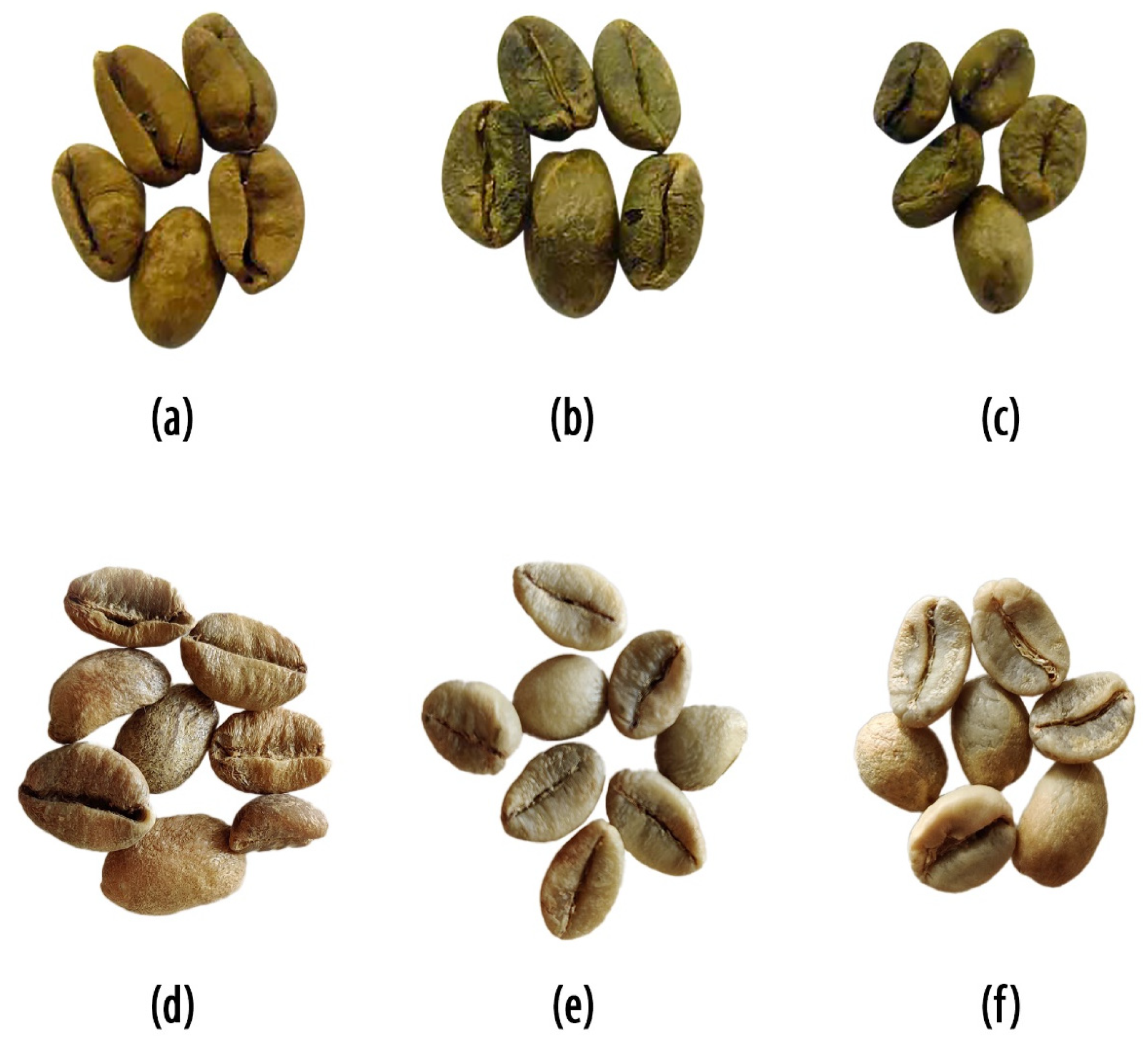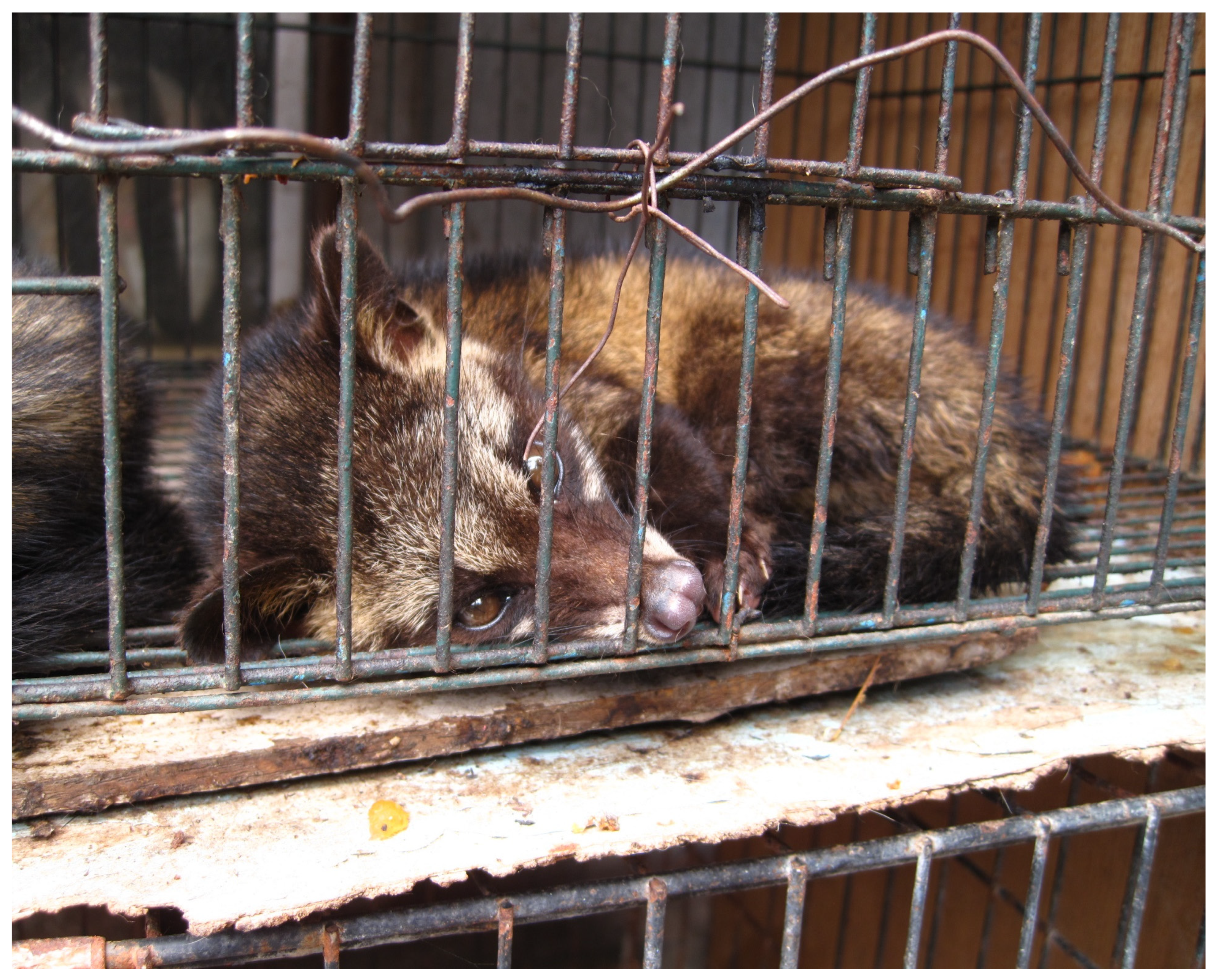1. Introduction
The topic of digested coffees is currently receiving a renewed interest and has recently been proposed as a “new trend in specialty coffee” [
1].
In this commentary, we want to point out the interesting issue of Coffea species assignment in the context of digested coffee studies. The first problem emerges when chemical studies are conducted in non-coffee growing countries, and sampling relies on commercial suppliers, often with doubtful authenticity. The control group is also problematic in the digested coffee studies, as wild civets may select the sweetest, most ripe, and healthy cherries, while the control coffee of commercial quality may include different stages of ripeness and the typical amount of defective beans. For example, it makes no sense to use a Brazilian C. arabica coffee as control group for Kopi Luwak from Indonesia. Geographical and variety differences within C. arabica alone may explain the observed differences.
The second problem with digested coffees is that many studies may have missed that the actual coffee species under investigation has been
Coffea liberica, not
Coffea arabica or
Coffea canephora, which has been incorrectly assumed. This hypothesis was first raised during an international roasting competition for Liberica coffee [
2].
2. A Short Critique of Previous Digested Coffee Studies
The study of Marcone [
3] is currently the most widely cited study on digested coffees according to Google Scholar (187 citations in June 2021). Marcone [
3] obtained Kopi Luwak and control beans (not having gone through the palm civet) from a supplier in California. Both the Kopi Luwak and control coffee beans were claimed as being Indonesian
Coffea canephora var. robusta. The study also included African civet coffee collected in western Ethiopia. No species was provided for the Ethiopian coffee, which, however, should be assumed as being
Coffea arabica, the predominant species in Ethiopia. Marcone [
3] provided photographs of the studied beans (reproduced in
Figure 1a–c).
According to Marcone [
3], the beans were assigned as
C. canephora (
Figure 1a), and two types of Ethiopian coffee (
Figure 1b,c). However according to our assessment of the shapes, the beans are actually
C. liberica (
Figure 1a),
C. canephora (which is rather unusual for Ethiopia, therefore assumed as an adulterated product) (
Figure 1b), and
C. arabica (
Figure 1c). Please note the bulging and raised nature of the beans at the cut for liberica (
Figure 1a). Arabica and canephora are flat at the cut and equally high on both sides. In our opinion, the mislabeling is quite clear. For comparison purposes, we provide examples of authentic
C. liberica (
Figure 1d),
C. canephora (
Figure 1e) and
C. arabica (
Figure 1f). The fact that
C. liberica exhibits such a little-noticed existence is surely one of the reasons why this circumstance escaped the authors of Kopi Luwak studies and reviews [
1] thus far. The species difference may also explain the different surface morphology of the beans [
3]. The discrimination ability of some analytical methods can also be explained in that two different coffee species were compared against each other (i.e.,
C. liberica in Kopi Luwak vs.
C. arabica as control group, e.g., compare Jumhawan et al. [
4,
5,
6] and Suhandy and Yulia [
7]).
3. Kopi Luwak a Coffea liberica in Disguise?
The distinctly different taste and highly valued flavor of Kopi Luwak coffee may be caused by the pure fact that it is Coffea liberica, which has a completely different flavor, with very complex profile compared to the commercial coffee species C. arabica and C. canephora. C. liberica has the highest sugar content of all coffees, and thus has the highest risk of fermentation. The sugar content may also be the reason that the civets and other coffee consuming animals prefer C. liberica over the other species, if they are available in the same area.
Diligently prepared C. liberica shows intense fruity and floral notes (strawberry, jackfruit, mango, banana) and a lactic character (yogurt, cream, mascarpone, crème fraiche) with a pronounced body and intense sweetness. When roasted too dark, the coffee offers notes that reach into the realm of ripe, sweet blue cheese and cheddar.
The lactic, cheesy, perhaps also animalic character of C. liberica may be easily misinterpreted as an influence potentially caused by animal digestion or intra-animal fermentation (i.e., the alleged change in taste caused by digestive enzymes of the animals), which are not convincingly proven in previous scientific studies. Currently, there are no sensory or chemical studies available investigating the possibility to distinguish Kopi Luwak from regular coffee prepared from Coffea liberica species.
One of the first descriptions of Kopi Luwak, from Brehm in 1883 [
8], suggested that the civet released the undigested seeds, that the excrement consisted entirely of caked, but incidentally undamaged coffee beans, and that the animals provide the very best coffee because they ate the ripest fruits. This description stands largely unchallenged to this day, and the scientific proof for the alternative hypothesis, that animal digestion actually changes the coffee and its flavor profile, so far lacks convincing proof. Due to the animal cruelty involved, we believe that this question does not necessarily need further investigation. Ripe and sweet coffee cherries of
C.
liberica may be selected by means other than the use of animals.
4. Conclusions
The authors believe that digested coffee is rather a perverted trend in specialty coffee, especially if the civet cats are kept in captivity purely for the purpose of coffee production [
9] (
Figure 2). In this regard, it is almost a relief that much coffee labelled as “Kopi Luwak” is probably a counterfeited product that has never seen the digestive tract of an animal (42% of Kopi Luwak were claimed as being found to be either complete fakes or adulterated with regular coffee beans [
10]).
Hopefully, the observation that an already valued specialty coffee such as Kopi Luwak may actually be Coffea liberica will encourage a new debate on this species in coffee cultivation, especially against the backdrop of climate change. It would certainly be desirable for the diversity of flavors in coffee, as well as avoid animal cruelty for an unnecessary procedure.
Author Contributions
Conceptualization, D.W.L. and S.S.; writing—original draft preparation, D.W.L.; writing—review and editing, S.S. All authors have read and agreed to the published version of the manuscript.
Funding
This research received no external funding.
Data Availability Statement
No new data were created or analyzed in this study. Data sharing is not applicable to this article.
Conflicts of Interest
S.S. is owner of Coffee Consulate, Mannheim, Germany. Coffee Consulate is an independent training and research center. Coffee Consulate is not commercializing digested coffees. Therefore, S.S. reports no conflicts of interest related to the work under consideration. D.W.L. declares no conflicts of interest.
References
- Raveendran, A.; Murthy, P.S. New trends in specialty coffees—“The digested coffees”. Crit. Rev. Food Sci. Nutr. 2021, 61. [Google Scholar] [CrossRef]
- Coffee Consulate. Liberica Coffee International Roasting Competition 2019; Coffee Consulate: Mannheim, Germany, 2019; Available online: https://www.coffee-consulate.com/media/09/59/e8/1592404961/Booklet_LibericaRoastingCompetition2019.pdf (accessed on 8 June 2021).
- Marcone, M.F. Composition and properties of Indonesian palm civet coffee (Kopi Luwak) and Ethiopian civet coffee. Food Res. Int. 2004, 37, 901–912. [Google Scholar] [CrossRef]
- Jumhawan, U.; Putri, S.P.; Yusianto; Bamba, T.; Fukusaki, E. Quantification of coffee blends for authentication of Asian palm civet coffee (Kopi Luwak) via metabolomics: A proof of concept. J. Biosci. Bioeng. 2016, 122, 79–84. [Google Scholar] [CrossRef] [PubMed]
- Jumhawan, U.; Putri, S.P.; Yusianto; Bamba, T.; Fukusaki, E. Application of gas chromatography/flame ionization detector-based metabolite fingerprinting for authentication of Asian palm civet coffee (Kopi Luwak). J. Biosci. Bioeng. 2015, 120, 555–561. [Google Scholar] [CrossRef] [PubMed]
- Jumhawan, U.; Putri, S.P.; Yusianto; Marwani, E.; Bamba, T.; Fukusaki, E. Selection of discriminant markers for authentication of Asian palm civet coffee (Kopi Luwak): A metabolomics approach. J. Agric. Food Chem. 2013, 61, 7994–8001. [Google Scholar] [CrossRef] [PubMed]
- Suhandy, D.; Yulia, M. The use of partial least square regression and spectral data in UV-visible region for quantification of adulteration in Indonesian palm civet coffee. Int. J. Food Sci. 2017, 2017, 6274178. [Google Scholar] [CrossRef] [PubMed]
- Brehm, A. Musang (Paradoxurus fasciatus). In Brehms Thierleben. Allgemeine Kunde des Thierreichs, Zweiter Band, Erste Abtheilung: Säugethiere, Dritter Band: Hufthiere, Seesäugethiere; Verlag des Bibliographischen Instituts: Leipzig, Germany, 1883; pp. 31–34. Available online: http://www.zeno.org/nid/20007931662 (accessed on 8 June 2021). (In German)
- Lynn, G.; Rogers, C. Civet Cat Coffee’s Animal Cruelty Secrets; BBC News: London, UK, 2013; Available online: https://www.bbc.com/news/uk-england-london-24034029 (accessed on 8 June 2021).
- Davies, D. Eat Up—And Don’t Forget the Palate Cleansers; NPR: Washington, DC, USA, 2007; Available online: https://www.npr.org/templates/story/story.php?storyId=11847227 (accessed on 8 June 2021).
| Publisher’s Note: MDPI stays neutral with regard to jurisdictional claims in published maps and institutional affiliations. |
© 2021 by the authors. Licensee MDPI, Basel, Switzerland. This article is an open access article distributed under the terms and conditions of the Creative Commons Attribution (CC BY) license (https://creativecommons.org/licenses/by/4.0/).








